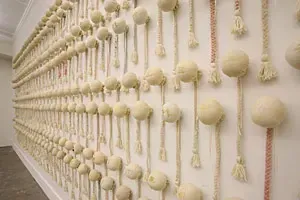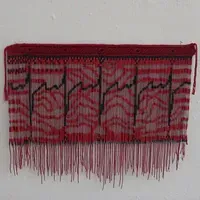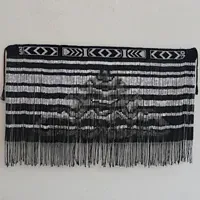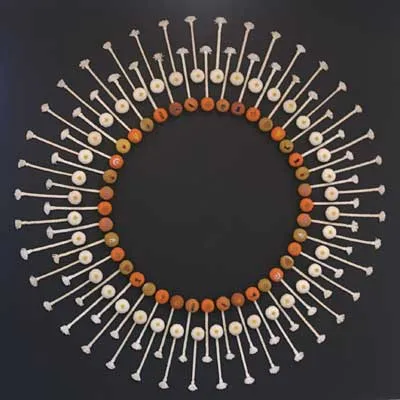Explosive Expression
Written by

By Mark Amery
This month there’s an impressive array of contemporary Maori art practice on display in the Wellington region.
A stunning show of Ngatai Taepa’s sculpture has just finished at Page Blackie, but he also features in a strong group exhibition at Pataka, Ki Mua ki Kuri, six leading artists linked by having all taught at Massey University’s School of Maori Studies.
This sits at Pataka alongside a 10 year survey of the work of Wayne Youle, and both exhibitions were joined in Porirua over the weekend by Toi Maori’s Maori Art Market.
What is pronounced in a range of exhibitions in central Wellington currently however is how art can change us through illuminating the spirit that shines on from events, both historical and contemporary.
It’s not all dots at City Gallery at present – on the top floor up the back Ngaahina Hohaaia’s stunning installation of embroidered poi brings new life to the story of the invasion of Parihaka by government troops in 1881. There’s a neat thread leading from this up Cuba Street - with stops at Bartley and Company and Peter Mcleavey’s along the way - to Thistle Hall where Hohaia is among an eclectic array of artists contributing to Explosive Expression: Creative Resistance to the State Terror Raids of October 2007. The artwork is to be auctioned this Saturday at 7pm to raise funds for those still facing charges from the raids.
We’re comfortable with art discussing our past societal tensions and disconnections. But it’s symptomatic of how insulated contemporary art can feel from the pain felt in the wake of tragedies in the present that Robin White’s exhibition Sorry at Peter McLeavey Gallery comes like a beautiful, disarming bolt out of the blue.
Sorry speaks to the spiritual effects for White’s Wairarapa community of a series of tragic deaths of children at the hands of adults several years ago. Collaborating with other local artists, White explores the physical representation of these children’s continued presence in people’s hearts and minds. The exhibition is deeply affecting, shaking out the numbness that years of newspaper and court reporting has cast over such events.
Amongst a set of four piupiu made with Holly Jackson two are made out of plastic tubes and newspaper and office paper tightly rolled, with fragmented sections of sentences visible referring to the sexual assault and death of toddler Hinewaoriki Karaitiana-Matiaha. One is made in a size a young child would wear and bears the heartbeat pattern of a hospital life support monitor. Another has a Taniko band featuring the road sign symbols near where she died in place of traditional designs. The black and white tones of the newspaper and plastic are carefully arranged to lay out the pattern in the piupiu of a moth, a symbol of impending danger and the duality of darkness and light to be found in life.
In other piu piu the moth pattern is paired with a taniko pattern featuring a native buttercup. The nectar from this buttercup is deadly but they are the host plant for the moth, with the more poisonous the nectar the more vivid the pattern on the moth’s wings.
The spirit is represented moving in the air in all the works. Made with weaver Robyn McFarlane ‘For the child gone so far’ is a cloak made from a plastic wool bale depicting the landscape (in a style we are familiar with from the past from White) of Lake Onoke where six year old Coral Burrows was killed. The air is full of hot air balloons, like those on a child’s pyjamas or blanket.
Such tangible, yet ordinary reminders of children, and their place in comfort and loss, are also aired in a series entitled ‘Let the Light Shine On’. Depicted in the shape of rainbows (perhaps representing new beginnings), as monoprints these works are flat and not particularly effective. The images come to life however concertinaed as a limited edition of printed fans, held in sheaths made out of a child’s woolly blanket depicting hearts, butterflies and stars. They depict disturbingly intimate, banal views from the sleepout of the murdered young sisters Olympia Jetson and Saliel Aplin. We look out past trees and pyjama trousers flapping in the wind to the sky beyond.
Sorry, Robin White, Holly Jackson and Robyn McFarlane, Peter McLeavey Gallery, ends October 24


